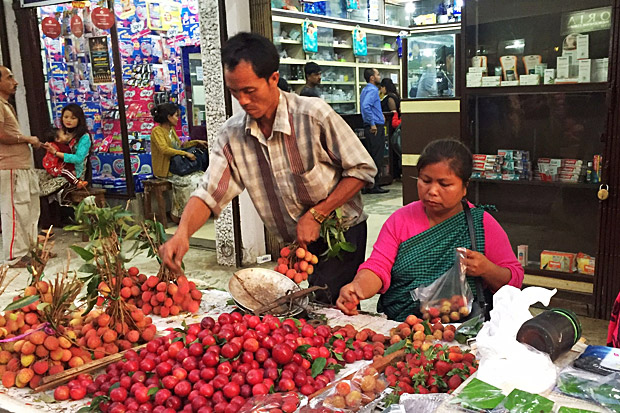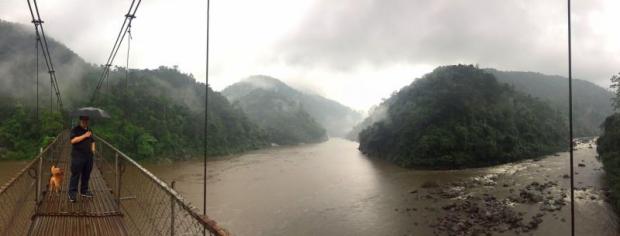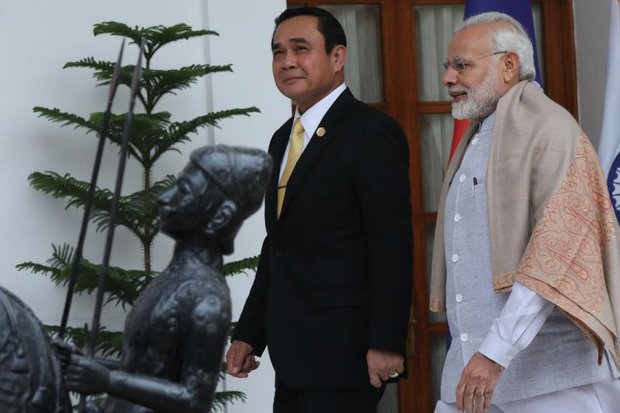
The fourth Act East Business Show was held on June 1 in Shillong, the capital of the state of Meghalaya in northeastern India. It was my first time out of New Delhi as the new Thai ambassador to the country, having presented my credentials to President Pranab Mukherjee just two weeks earlier.
India's Northeast Region (NER) or "India's Isan", comprising seven sister states and one brother, independent Sikkim, has been portrayed by India as the beginning of Southeast Asia and a gateway to Asean. Furthermore, Shillong is known as the Scotland of the East, and rightfully so, with its mountains and cool climate.
The grand vision painted in the capitals of India and the 10 Asean member states is of combining markets of 1.2 billion and 620 million people, respectively, with air, sea and land connectivity, focusing on the India-Myanmar-Thailand Trilateral Highway.

Thai Ambassador Chutintorn Gongsakdi visits a bridge crossing the Umngot River in Dawki, Meghalaya state.
It is indeed a great and worthy vision. India and Asean, which are celebrating 25 years as dialogue partners this year, are two of the fastest growing regions in the world with great prospects. They also complement each other in numerous fields -- high tech, manufacturing, agriculture and services. In addition, they are geographically contiguous and have a shared culture. They have compelling reasons to invest in a shared future.
And yet, one's perspective changes as the modern IndiGo jet travelling from the metropolis of New Delhi lands in Guwahati, the largest city in the Northeast. The India-Asean dream as seen from the perspective on the ground needs translation from the visionary into the practical.
Conversations at the Asean-India Studies Centre, set up in 2016 at the North-Eastern Hill University (NEHU) in Shillong, and with local stakeholders, bring calls for a more tangible and down-to-earth response to local needs. Value addition to local agricultural products and sustainable tourism came to the forefront of our discussions.
Over subsequent days during my stay, an invitation was also extended to CP Foods Plc (CPF), Thailand's biggest agribusiness concern, to invest in food processing in India's Northeast. In fact, CPF had assessed the viability of setting up in the state of Assam three years ago. Maybe it is time to reevaluate.
Other potential areas of interest include Otop (One Tambon, One Product), Geographical Indication (GI), agricultural biotechnology, sustainable and high-value tourism.
The key message is that the Asean-India connection, as with any other grand visions that originate in conference rooms, has to deliver on the ground, to the last individual, leaving no one behind.
At the fourth Act East Business Show, products were displayed and traded. Local entrepreneurs are very smart. Coffee growers have already grasped the concepts of GI and "fair trade" labelling for value addition. A little more international design input and marketing, including e-commerce, could take them very far.
Meanwhile, at the inaugural session and another session on Northeast India and Asean Trade and Connectivity, it was emphasised again that the people on the ground were still waiting for visible deliverables. Youth delegates were sold by this ambassador on the economic potential of Asean-India, especially on the ground in India's Northeast and in Myanmar, Laos and Cambodia in particular.
Both India and the Asean Community are about to take off economically in big ways and the youth of this region are lucky to be born into this land of opportunity. Emphasis was placed on Cambodia, Laos and Myanmar or CLM as the lower cost of investment means that this trio of countries is an even brighter investment prospect for manufacturing.
Countries such as Thailand, where labour costs are rising, are having to move further up the value chain and shift production into the CLM markets. India is being invited to strengthen its ties with Asean and invest in this vibrant region too, building on the physical links with the Northeast.

Thai Ambassador Chutintorn Gongsakdi visits a bridge crossing the Umngot River in Dawki, Meghalaya state. SUPPLIED
I envisage Indian manufacturers of consumer goods, motor vehicles and parts, as well as service providers, such as in education and health, entering the Asean market through a presence in the CLM countries. At the same time, industries and services based on industrial science and technology can target other parts of the Asean Community.
Thailand and India are both undergoing reform and transformation. A closer look will show that there are uncanny similarities in our reforms, whether it be anti-corruption, taxation, infrastructure, high-tech industries or social inclusiveness.
A key area of complementarity lies with India wanting to increase its manufacturing base and Thailand wanting to build up its services sector. Hence, the Thailand-India-Asean partnership is a match made in heaven and too valuable to miss.
What needs to be done before the fifth Act East Business Show? We need to start serious collaborative research between Chulalongkorn University's Indian Studies Center and the Asean Studies Centre in NEHU, perhaps on making the Northeast Region and CLM a true economic corridor.
We also need to pursue targeted capacity-building on the ground in areas such as customs, immigration and quarantine, sustainable tourism, agriculture biotechnology and community-based entrepreneurship.
At a higher level, we need to have an economic roadmap for the Northeast Region on the Indian side and likewise a roadmap for the Mekong subregion (CLM plus Thailand and Vietnam) on the Asean side. Last, but not least, we need Thais and Indians to rediscover their common roots and rekindle past links.
Chutintorn Gongsakdi is the Thai Ambassador to India.


